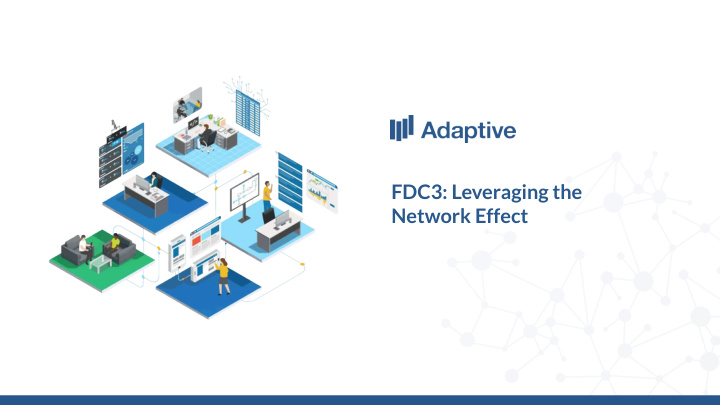



FDC3: Leveraging the Network Effect Bhavesh Desai Head of UI @ Adaptive
Who am I? My history Started as a software developer in Cape Town, SA ● Have worked in the finance industry for 15+ years ● Everything from Delphi and ASP, WPF and Flash, to HTML5 and React ● At Adaptive Financial Consulting Head of Desktop Strategy ● Worked on several industry-leading desktop platforms ● Advising clients on desktop technologies, collaboration and workflow ● At FINOS FDC3 PMC Member ● Chair of the API Working Group ●
“ Over the past 23 years, network effects have accounted for approximately 70% ” of the value creation in tech. - Nfx
The Network Effect: Creating Value Study looking at 336 companies from 1994-2017 > $1 billion ● 35% had network effects at their core, adding up to 70% of the value created ● Network effects have asymmetric upside ● Single most predictable attribute of highest value tech companies ●
Nodes and Links Nodes = network participants ● Links = connections between nodes ● Depending on characteristics, networks ● scale exponentially in value
Reaching Critical Mass There are different types of networks (e.g. physical, protocol, platform, data etc.) ● Networks need to reach a critical mass before realising their value ●
Establishing a Network: Microservices Microservices are one way to establish lightweight nodes in a software network ● Services are linked via standardised communication: HTTP ● Allows breaking down complex systems into smaller parts ● Continued innovation in this area: Docker, Cloud, OpenAPI, etc. ●
Advantages of a Decoupled Architecture High maintainability and testability ● Standardised communication patterns ● Independently deployable ● Organized around business capabilities ● Small, autonomous teams ● Evolution of technology stack ●
Architectural Evolution I Monolith Client-Server Microservices Frontend Team Frontend Team Front End Aggregation Layer Back End Application Team Ref Data Service Analytics Service Pricing Service Backend Team Auth Service Database
Architectural Evolution II Back End Front End Pricing Service Pricing Micro-frontends Ref Data Service Blotter Analytics Analytics Service Auth Service Login Application Network
Frontend Networks A componentized desktop ● Enabled by web technologies & desktop containers ● How do we define communication links between applications? ● Can we do it in a simple, standardised way that spans organisations? ● Enable us to leverage network effects and unlock value ●
“Financial Desktop Connectivity and ● Collaboration Consortium” Started by OpenFin in 2017 ● Contributed to the Fintech Open Source ● Foundation (FINOS) Open standards for the financial desktop FDC3 1.0 specifications released in March ● 2019 https://fdc3.finos.org ●
Best Web Development APP DIRECTORY INTENTS CONTEXT DATA API A shared way to A shared set of A shared language for A shared set of register and discover well-known verbs describing data interoperability applications operations
Chat Alert Streaming Price
In Summary Network effects are critical for unlocking value ● Microservices = decoupled HTTP-linked services ● Micro-frontends = decoupled FDC3-linked applets ● Open, connected applications are: ● Powerful inside our organisations ○ Even more so, across our industry ○
Q&A Follow me: https://www.linkedin.com/in/rikoe/ @rikoe riko@weareadaptive.com github.com/rikoe
Recommend
More recommend